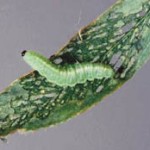CNSC / The U.S. Department of Agriculture surprised some analysts Wednesday by leaving seeded area estimates unchanged for all U.S. crops. Before the report, a poll of grain analysts by Reuters found expectations were for corn acres to drop 1.5 million acres and soybean acres to rise 700,000 due to seeding difficulties this spring. Over
McMillan: USDA area estimates surprise trade
McMillan: USDA area estimates surprise trade
The U.S. Department of Agriculture surprised some analysts Wednesday by leaving seeded area estimates unchanged for all U.S. crops. Before the report, a poll of grain analysts by Reuters found expectations were for corn acres to drop 1.5 million acres and soybean acres to rise 700,000 due to seeding difficulties this spring. Over the past

Is alfalfa weevil taking a bite out of your forage crop?
Researchers are working on an interactive map to help producers assess potential for weevil infestations
Many Saskatchewan forage growers dutifully waited for alfalfa to reach the 15 per cent bloom stage before cutting last year, but their patience went unrewarded. Thanks to the alfalfa weevil, a nasty little pest that has been gradually spreading across the southern Prairies since its arrival here in the 1950s, they were waiting for aMcMillan: India’s pulse crops await delayed monsoon
A top market for Canadian pulse crops and oilseeds now expects to wait a few extra days for the rains on which its own pulse and oilseed crops rely heavily. India’s government meteorological department announced Thursday that conditions were favourable for the onset of the southwest monsoon in the state of Kerala by Tuesday (June
McMillan: Southern Alta. winter wheat prevails
Winter wheat crops are reported thriving across Alberta, contrasting multiple reports of challenges in the eastern Prairies. Manitoba Agriculture, Food and Rural Initiatives reported Monday that reseeding of winter wheat is occurring throughout the province due to poor plant stands. The Saskatchewan government reported Thursday that some winter wheat fields in that province’s southeast are
Cutting alfalfa an early line of defense against weevil
It may be a small pest, but alfalfa weevil has been making a big impact across Western Canada and may still be running below some forage producers’ radar. The main feeding period for the pest runs from mid-June to mid-July — making it a primary concern for first-cut alfalfa in areas where the pest is
McMillan: U.S. farmers plant corn at breakneck pace
Warmer temperatures and dry skies across growing areas of the U.S. have allowed farmers to make huge gains in seeding activities — although the haste to plant may not necessarily produce the best crop. Across the U.S., farmers raced to get crops sown after a slow start to the 2013 season. The changing weather was
McMillan: U.S. drought area down, but very dry areas drier
Total U.S. farmland under drought edged lower over the week ending May 21, according to the U.S. Drought Monitor’s Thursday update. During that week, the area ranked as having no drought impact at all moved from 38.3 to 39.1 per cent, as a result of heavy rain over the northern Plains and Midwest, according to
McMillan: Northern Plains planting grinds to a halt
Planting problems resume for northern U.S. farmers. In what was already a very slow start to seeding, farmers were stopped by rains so heavy that flash flood warnings were issued for southeastern North Dakota and western Minnesota. The slow-moving weather system brought heavy rains to already-saturated ground. Over the past three days these areas received
McMillan: Prairie crop insect pressure light, so far
With warming weather come weeds and pests. So far insect pest numbers on the agricultural Prairies have been light — although that can change quickly. “Given the late spring, no hot issues have popped up yet.” said Brent Flaten, integrated pest management specialist with Saskatchewan Agriculture in Moose Jaw. During a recent Twitter chat, Alberta

